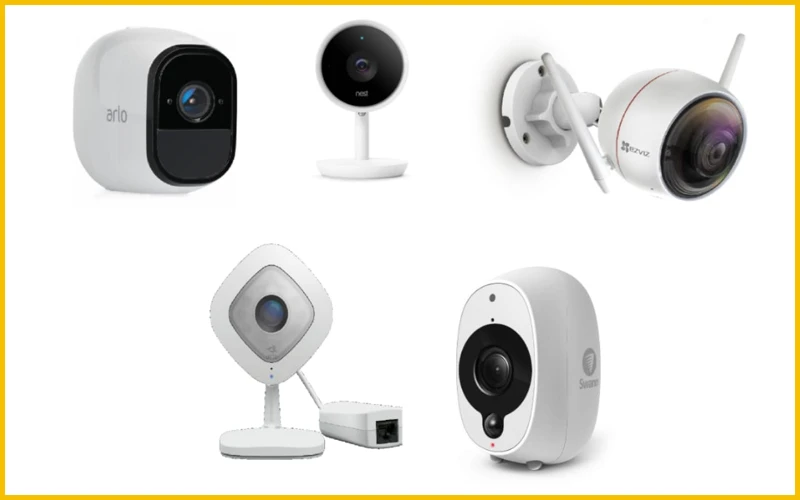In the realm of video surveillance, technological advancements have been rapidly evolving, with wireless camera technology playing a pivotal role in enhancing security measures. The future of wireless camera tech in video surveillance holds immense potential for revolutionizing how we monitor and protect our spaces. From improved connectivity to enhanced image quality and advanced features, the possibilities are endless. This article delves into the exciting developments in future wireless camera technology for video surveillance and how it is set to shape the future of security systems.
Enhanced Connectivity with 5G

One of the key drivers of future wireless camera technology in video surveillance is the integration of 5G connectivity. With its ultra-fast speeds and low latency, 5G technology is set to revolutionize how wireless cameras transmit data and communicate with monitoring systems. The increased bandwidth and reliability of 5G networks will enable seamless streaming of high-definition video footage, ensuring real-time monitoring and response capabilities like never before.
Benefits of 5G in Video Surveillance
– Improved video quality: 5G technology allows for higher resolution video streaming, enabling clearer and more detailed footage for better identification of individuals and objects.
– Faster response times: With lower latency provided by 5G networks, security personnel can receive alerts and respond to incidents in real-time, enhancing overall security measures.
– Enhanced reliability: The robust connectivity of 5G networks ensures continuous and stable video transmission, reducing the risk of disruptions in surveillance operations.
AI-Powered Smart Cameras

The future of wireless camera tech in video surveillance also involves the integration of artificial intelligence (AI) capabilities into smart cameras. AI-powered cameras have the ability to analyze video data in real-time, enabling advanced features such as facial recognition, object detection, and behavior monitoring. These smart cameras can distinguish between normal activities and potential security threats, providing a proactive approach to surveillance.
Features of AI-Powered Smart Cameras
– Facial recognition: Smart cameras equipped with AI can identify individuals and cross-reference them with databases to enhance security measures and track suspicious persons.
– Object detection: AI algorithms can detect and classify objects in video footage, alerting security personnel to unauthorized items or potential threats.
– Behavior monitoring: Smart cameras can analyze patterns of behavior and raise alerts for any deviations from normal activities, helping prevent security incidents before they occur.
Cloud-Based Storage and Analytics

Another significant advancement in future wireless camera technology for video surveillance is the shift towards cloud-based storage and analytics. By storing video footage in the cloud, organizations can access their surveillance data remotely, securely, and at scale. Cloud-based analytics also enable advanced video processing capabilities, such as video indexing, search, and real-time monitoring.
Advantages of Cloud-Based Video Surveillance
– Scalability: Cloud-based storage allows for flexible storage options, accommodating varying amounts of video data without the need for physical storage devices.
– Remote access: Users can access video footage from any location with an internet connection, enabling real-time monitoring and management of surveillance systems.
– Cost-effectiveness: Cloud-based storage eliminates the need for expensive on-premises hardware and maintenance, reducing overall operational costs for organizations.
Edge Computing for Real-Time Processing
In the realm of future wireless camera technology, edge computing is emerging as a key trend for enabling real-time video processing and analysis at the network edge. By processing data closer to the source, edge computing reduces latency and bandwidth usage, making it ideal for applications that require immediate insights from video surveillance footage.
Benefits of Edge Computing in Video Surveillance
– Low latency: Edge computing allows for faster processing of video data, enabling real-time analytics and response to security events without delays.
– Bandwidth optimization: By processing data locally, edge computing reduces the amount of data that needs to be transmitted to centralized servers, optimizing network bandwidth.
– Enhanced privacy: Edge computing keeps sensitive video data closer to the source, minimizing the risks of data breaches and ensuring greater privacy and security for surveillance footage.
Enhanced Cybersecurity Measures
As wireless camera technology continues to evolve, cybersecurity remains a critical consideration for ensuring the integrity and confidentiality of video surveillance data. The future of wireless camera tech in video surveillance will see advancements in cybersecurity measures, including encryption protocols, secure authentication mechanisms, and intrusion detection systems to safeguard against cyber threats.
Key Cybersecurity Considerations
– Encryption: Implementing strong encryption protocols ensures that video data is securely transmitted and stored, protecting it from unauthorized access and interception.
– Secure authentication: Multi-factor authentication and biometric access controls help prevent unauthorized users from tampering with surveillance systems or gaining access to sensitive data.
– Intrusion detection: Advanced intrusion detection systems can detect and mitigate cyber threats in real-time, safeguarding against potential breaches and unauthorized access to video surveillance networks.
Integration with IoT Devices
The future of wireless camera technology in video surveillance will also see increased integration with Internet of Things (IoT) devices to create a seamless and interconnected security ecosystem. By connecting wireless cameras with IoT sensors, alarms, and access control systems, organizations can enhance their surveillance capabilities and create a more comprehensive security infrastructure.
Benefits of IoT Integration in Video Surveillance
– Automated alerts: IoT devices can trigger alerts and notifications based on predefined criteria, such as motion detection or environmental changes, enabling proactive responses to security incidents.
– Data correlation: By integrating data from various IoT devices, organizations can gain a holistic view of their security environment, identifying patterns and trends to improve overall surveillance measures.
– Enhanced interoperability: IoT integration allows for seamless communication between different security systems, enabling centralized management and control of surveillance operations.
Future Applications and Use Cases
Looking ahead, the future of wireless camera tech in video surveillance holds immense potential for a wide range of applications and use cases across various industries. From smart cities and transportation systems to commercial buildings and residential properties, wireless cameras will play a crucial role in enhancing security, safety, and operational efficiency.
Potential Applications of Future Wireless Camera Tech
– Smart city monitoring: Wireless cameras integrated with AI and IoT technologies can enable smart city initiatives, such as traffic monitoring, crowd management, and public safety enhancements.
– Retail analytics: Smart cameras equipped with AI-powered analytics can provide valuable insights into customer behavior, foot traffic patterns, and inventory management in retail environments.
– Home security: Wireless cameras with cloud-based storage and remote access capabilities offer homeowners intuitive and convenient ways to monitor their properties and enhance residential security measures.
Interested in the future of wireless camera technology in video surveillance? Explore our articles on evaluating performance of wireless vs. wired video surveillance, wired vs. wireless outdoor video surveillance, wired vs. wireless video surveillance, and wireless vs. wired video surveillance systems for a deeper understanding of the latest advancements in the industry!
Conclusion
In conclusion, the future of wireless camera technology in video surveillance is poised to bring about transformative changes in how we approach security and monitoring. From enhanced connectivity with 5G to AI-powered smart cameras, cloud-based storage, and edge computing, the possibilities for innovation and advancement are endless. By embracing these cutting-edge technologies and integrating them into our security systems, we can create safer, smarter, and more efficient environments for all. The future of video surveillance with wireless camera tech is indeed a promising and exciting frontier that holds great potential for shaping the security landscape of tomorrow.







